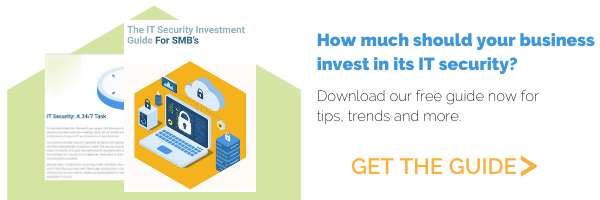Threat Intelligence: Why It's So Important and How to Implement It

Threat intelligence might be a term you’ve come across recently. It’s basically used to describe the information a business gathers to understand the cyberthreats it’s facing. With this knowledge, they can then prepare their network against future attacks and ensure the protection of the whole business. Straightforward enough.

What’s less straightforward is actually putting the idea of threat intelligence into practice. In this post, we’ll outline why threat intelligence is so important and a quick step-by-step guide.
Why Is Threat Intelligence Important?
You don’t need us to tell you how critical cybersecurity is for businesses. Looking at the latest UK figures, it shows that 32% of businesses have experienced a breach of some kind in the last 12 months.
Of those affected by a breach, 19% saw their staff have to completely down tools because of the fallout and 32% needed to implement entirely new security measures in the aftermath. To avoid being a part of these statistics, businesses must be proactive with their IT security, not reactive.
This is where threat intelligence comes in. It takes raw data about the latest threats that are putting businesses at risk, collates this information and then produces reports that you can use to proactively protect your network.
Threat intelligence is crucial for any business because with real-time critical information you’ll know which threats to be aware of and can implement fixes before issues even arise.
In the world of cybersecurity, defenders are constantly trying to outmanoeuvre each other - if organisations want to know their adversary’s next moves they can proactively tailor their defences and preempt future attacks.
It’s most useful when training staff. If there’s a new type of phishing scam or impersonation attack rising in popularity with thieves, threat intelligence allows you to give your employees a heads-up well in advance.
Internal staff are often the biggest cause of breaches, either maliciously or just by accident. Threat assessments monitor what users are doing and flag unusual behaviour.
Threat intelligence leads to far better communication at all levels of the business. Knowing threats in advance gives you the time to explain the situation to stakeholders, management and all members of staff and outline what the potential impact might be.
In practice, threat intelligence looks like a list of domains that are blocked or newly-created firewall rules. The results speak for themselves - a reduction in unplanned downtime, faster resolution of threats and a more efficient IT security team.
Without it, you’re working blind and at risk of the next WannaCry or NotPetya. Implementing threat intelligence requires time, energy and resources. Here’s how to get started.
Implementing Threat Intelligence: A Step-by-Step Guide
1. Carry Out an Audit of Your Systems
A good place to start is with an audit of your existing security processes. Who would benefit from threat intelligence at your business? What measures do you currently have in place to prevent breaches?
Start by listing everything that keeps your business running and decide on priorities. Then, draw up objectives that outline what the threat intelligence process should achieve. How do you want it to work and who would be responsible at the various stages?
2. Data Collection
You’ll need to gather raw data from a few different places - network event logs, previous breaches and external sources are all good starting points. Key indicators like IP addresses, domains and customer data are all collected at this stage.
At this point, you’ll have a huge volume of uncategorised data. By using metadata tags and thorough filters, you can remove redundant information and ensure you only work with valuable data.
3. Keep Records of All Incidents
Previous incidents offer valuable insight into the gaps in your security. By keeping an incident database you’ll know what you’ve experienced and why it happened.
Every phishing attempt and social engineering email should be logged in one place. Eventually, you’ll have a better idea of what’s on the horizon and can adjust security strategies accordingly.
4. Turn on Intelligence Feeds
If there are parts of your security stack that have intelligence feeds that you aren’t currently using - turn them on. All information is valuable and if there are avenues you aren’t currently using to gather data then that should change.
These real-time streams of data provide excellent insight into potential threats that might be heading your way. By utilising them more effectively, you can compare the information coming in with internal data and better produce operational intelligence.
5. Distribute Information to the Right People
For the threat intelligence to be useful, the right people need to see it at the right time. Any type of delay or miscommunication means the whole process has been a waste of time and the business is at risk.
You’ll also need to think about managing reports as they’re sent to the relevant people. If something is accidentally missed and things fall through the cracks, then problems can quickly occur.
6. Collect Feedback and Reevaluate
Is the system working? Identify measurable KPIs to determine the effectiveness of the threat intelligence system. Has downtime decreased compared to previous periods? Do the right people have enough time to take action before a breach can take place?
If you think this is quite a complicated process that will take input from a large number of people, then you’re not wrong. For it to truly be a success, it might take some trial and error or even some retraining of existing team members.
Alternatively, you could seek the assistance of an MSSP like PSTG. As your partner, we’ll work with you to create a threat intelligence process that works. We can implement the whole thing seamlessly to ensure that your business is protected from threats that lurk around the corner.
Our Guide to IT Security
Threat intelligence is just one part of IT security you need to proactively think about. For an idea of the sort of investment you should make into your next security budget, make sure to download our free guide today. It’s packed with useful tips and best practices. Get your copy now using the link below.




